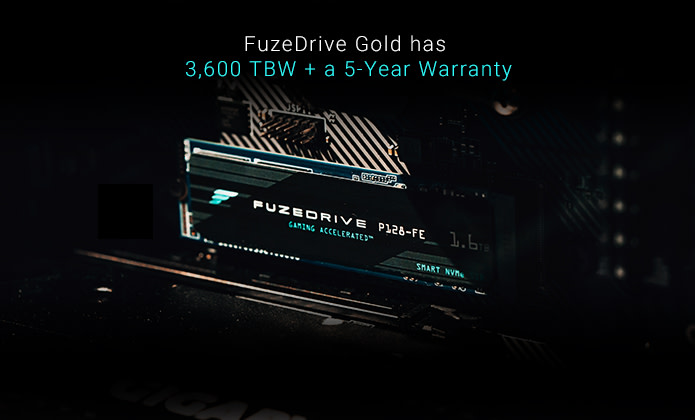FuzeDrive 1.6TB M.2 SSD Launches: Mixes SLC & QLC NAND for $259
Not sure whether to get an SLC or QLC drive? Why not both?
Balancing performance, endurance, capacity and price has always been a tricky space to navigate when looking for the best SSD. Enmotus' FuzeDrive aims to solve this dilemma. Available in 900GB and 1.6TB capacities, FuzeDrives just launched on Indiegogo for preorder and will ship in November.
Enmotus' FuzeDrive combines SLC and QLC flash -- hence the name -- even though the SLC is just QLC coded to behave like SLC. This means the FuzeDrive can dynamically shift data around to suit the user's needs. Data rewritten frequently and requiring fast speeds reside on the SLC section, with the bulk of data storage on the QLC flash. This works because SLC NAND doesn't wear out nearly as quickly as QLC NAND and is much faster in writing operations. Head here for a full technical deep-dive on FuzeDrive.
The drives are M.2 SSDs measuring 80mm long (as standard as it gets), along with an optional heatsink and lighting. They are supported on both AMD and Intel platforms, and you can clone your existing drive over to them if you want to avoid a full system re-installation. Read and write speeds are 3,470 MBps and 3,000 MBps, respectively.
“Enmotus developed a solution that reacts to the way the user actually uses their storage, rather than focus on raw speeds and feeds. We wanted to offer the community a device that performs more smoothly and consistently over it’s life,” said Andy Mills, CEO and co-founder of Enmotus.
“Furthermore, we wanted to offer a new classification system that helps users understand the level of endurance they are buying with any SSD now that we have much lower enduring type of NAND technology entering the market. This will greatly simplify the buying process for end users who are becoming increasingly concerned about the durability of the newer SSDs.”
Price
Pricing is surprisingly reasonable for a product as unique as this, but, then again, it has to be in order to compete with a full-SLC drive (not that they are easy to come by nowadays) or make the concession of using 100% TLC.
The 900GB variant with 24GB of SLC flash costs $159 with the launch discount on Indiegogo, and the 1.6TB variant packing 128 GB of SLC NAND is $259. Only 100 of the 1.6TB drives are available at this price though, so you'll have to be quick if you want one.
Get Tom's Hardware's best news and in-depth reviews, straight to your inbox.
You can find the Indiegogo page here.
Niels Broekhuijsen is a Contributing Writer for Tom's Hardware US. He reviews cases, water cooling and pc builds.
-
Giroro “Furthermore, we wanted to offer a new classification system that helps users understand the level of endurance they are buying"Reply
In other words, their endurance rating is a lie, because they decided they could arbitrarily redefine TBW?
And since the capacity of the "SLC configured" QLC flash is 25% of its maximum, the capacity is probably also a lie. -
Gillerer ReplyGiroro said:“Furthermore, we wanted to offer a new classification system that helps users understand the level of endurance they are buying"
In other words, their endurance rating is a lie, because they decided they could arbitrarily redefine TBW?
I believe the new classification system is the "Gold/Silver/Bronze Class Endurance", as listed on their indiegogo page. The 1.6TB gets Gold, 900GB gets Silver, and all regular QLC drives are Bronze.
Giroro said:And since the capacity of the "SLC configured" QLC flash is 25% of its maximum, the capacity is probably also a lie.
Assuming 2048 GiB (2199.02 GB) raw QLC NAND:
128 GB = 119.21 GiB pseudo-SLC consumes 512 GB = 476.83 GiB worth of QLC
1472 GB = 1370.91 GiB in QLC
128+1472 GB = the advertised 1600GB capacity
total 1984 GB = 1847.74 GiB raw QLC consumed
leaves 200.26 GiB or 9.78% (of 2048 GiB) for over-provisioning.Assuming 1024 GiB (1099.51 GB) raw QLC NAND:
24 GB = 22.35 GiB pseudo-SLC consumes 96 GB = 89.41 GiB worth of QLC
876 GB = 815.84 GiB in QLC
24+876 GB = the advertised 900GB capacity
total 972 GB = 905.25 GiB raw QLC consumed
leaves 118.75 GiB or 11.60% (of 1024 GiB) for over-provisioningChecks out and seems reasonable to me.
(Pseudo-)SLC has less need for over-provisioning, and the drive can probably lower the QLC write amplification too, sinceit can group writes into large chunks when migrating data from SLC to QLC. Leaving often overwritten data in SLC will be a huge boon here.

